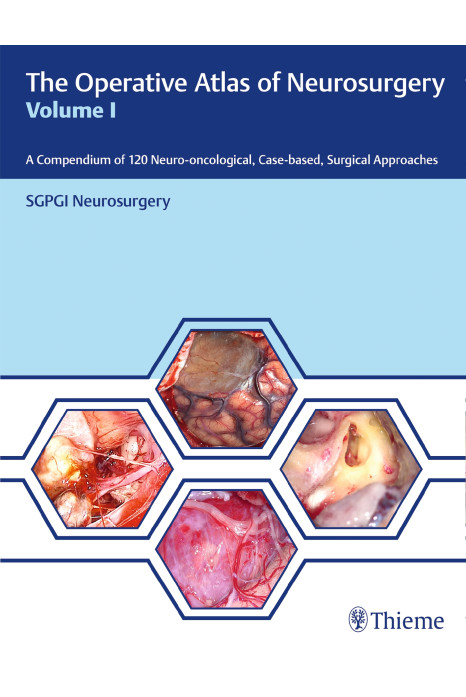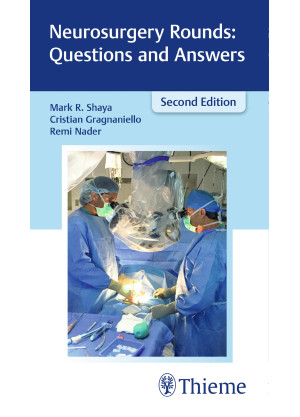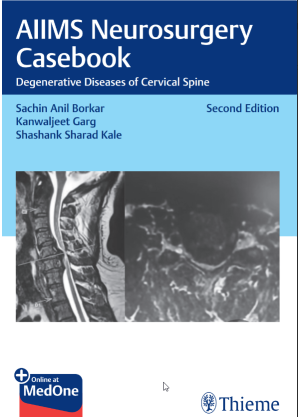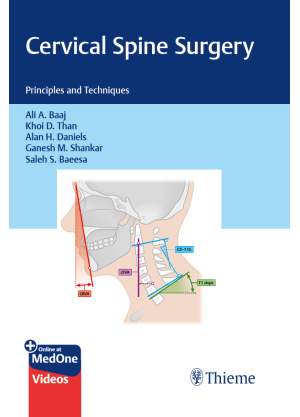Neuro-oncological surgery has rapidly emerged as one of the most demanding fields in neurosurgery, greatly benefitted by the advances in surgical and imaging procedures. The Operative Atlas of Neurosurgery: A Compendium of 120 Neuro-oncological, Case-based, Surgical Approaches serves the immediate requirement of a surgical atlas primarily focusing on neuro-oncology for surgeons and students alike. This book contains over a hundred case-based surgical procedures identifying microsurgical and endoscopic methods, and is spread over nine sections, divided into two volumes.
The purpose of this book is to provide a step-wise approach to the excision of tumors in the central nervous system, cranial vault, and spine, as well as the peripheral nerves. The first seven sections deal with these, while the last two sections deal with the adjunctive modalities used to facilitate the surgical procedures and the significance of the diagnostic modalities that have evolved over time, respectively. Minimally invasive techniques along with the conventional methods have been described in detail.
The cases have been presented by experienced neurosurgeons, otorhinolaryngologists, and skull base surgeons along with contributions from young doctors and residents who are just beginning this journey in their chosen field. The chapters have been intentionally kept small and crisp, thereby allowing busy neurosurgeons to gain maximum information in the shortest timespan and to apply the same in their work. This book will immensely benefit students and practitioners in the fields of neurosurgery, neurooncological surgery, and ENT.
Key Features:
- Sequential steps of the actual surgery have been depicted as successive photographs and their legends.
- Each chapter has sections comprising a brief overview of the pathology in focus, the nuances of the procedure conducted, as well as the various therapeutic options and operative approaches that are available.
- The methods related to "patient-safety issues," "complication avoidance," and the essential "tips and pearls" of surgery are discussed.
- Essential information on the relevant clinical neuro-anatomy is highlighted with illustrative schematic diagrams and photographs.
Volume I
Section 1: Microsurgery for Supratentorial Tumors
Chapter 1: Left Medial Temporal Ganglioglioma with Refractory Temporal Lobe Epilepsy—Lesionectomy with Selective Amygdalo-hippocampectomy
Chapter 2: Optico-chiasmatic Glioma—The Trans-Sylvian Corridor
Chapter 3: Resection of an Insular Glioma using a Transcortical Approach under Intraoperative Motor Mapping
Chapter 4: Awake Focused Craniotomy for Supratentorial Brain Tumors
Chapter 5: Temporoparietal Craniotomy for a Solitary Posterior Temporal Metastasis from an Unknown Primary
Chapter 6: Microsurgical En Bloc Resection of Hemispheric Gliomas
Chapter 7: Frontal Craniotomy and the Middle Frontal Gyrus Approach for the Simultaneous Excision of the Concurrently Existing Intraventricular Glioblastoma and Frontal
Chapter 8: Left Parietal Craniotomy for a Parietal High Grade Neuroepithelial Tumor with an Anaplastic Astroblastoma Phenotype
Chapter 9: Frontal Parasagittal Craniotomy and Excision of a Cortical Surfacing Metastatic Melanoma
Chapter 10: Wax-Pile Method for Insular Gliomas: Counteracting Brain-Shift in Intraoperative Magnetic Resonance Imaging
Chapter 11: Contralateral Posterior Interhemispheric Approach to a Medial Parietal Glioma
Chapter 12: Posterior Interhemispheric, Transcallosal, Interforniceal, Trans-Velum Interpositum, Trans-Ventricular Approach for the Excision of a Rostrally Located Midbrain Pilocytic Astrocytoma
Chapter 13: Pterional Approach for an Olfactory Groove Meningioma
Chapter 14: Lateral Supra-Orbital Craniotomy and a Subfrontal-Trans-Sylvian Approach for an Olfactory Groove Meningioma
Chapter 15: Parietal Parasagittal Craniotomy in Prone Position for Excision of a Parasagittal Meningioma
Chapter 16: Trans-Cavernous Sinus Resection of a Gamma Knife–treated Petrous Apex Meningioma with Cavernous Sinus
Chapter 17: Surgical Approach to a Medial Sphenoid Wing Meningioma
Chapter 18: Keyhole Supraorbital Hybrid Microscopic-Endoscopic Approach with Extradural Clinoidectomy for Excision of a Medial Sphenoid Wing Meningioma
Chapter 19: Anterior Interhemispheric Approach to a Sellar-Suprasellar Craniopharyngioma
Chapter 20: Anterior Third Ventricular Craniopharyngioma: The Pterional Trans-Lamina Terminalis Approach
Chapter 21: Fronto-Temporal Craniotomy, Trans-Sylvian Approach and Optic Nerve Mobilisation for a Calcified and Firm Suprasellar Craniopharyngioma
Chapter 22: Primary Central Nervous System Plasmablastic Lymphoma in the Left Eloquent Cortex: Intraoperative Ultrasound and Electrophysiological Monitoring-Guided Excision
Chapter 23: Interhemispheric Epidermoid: Excision Using a Supraorbital Key-hole Approach
Chapter 24: Anterior Interhemispheric Approach to an Interhemispheric Epidermoid
Chapter 25: Contralateral Pterional Trans-Lamina Terminalis Approach for the Disconnection of a Third Ventricular Hypothalamic Hamartoma
Chapter 26: Enucleation of the Globe for an Aggressive Retinal Hemangioblastoma in a Patient with Von Hippel-Lindau (VHL) Disease
Chapter 27: Temporal Craniotomy and Middle Temporal Gyrus Approach for the Excision of an Intraventricular Choroid Plexus Papilloma located in the Trigone in a Pediatric Patient 2
Chapter 28: Frontotemporal Craniotomy for a Temporal Para-Sylvian Arachnoid Cyst
Chapter 29: Micro-Neurosurgery of the Posterior Incisural Space
Chapter 30: Gravity Assisted Retraction-less Occipital Trans-tentorial Approach (GAROT) for Posterior Third Ventricular Tumors
Chapter 31: Infratentorial Supracerebellar (ITSC) Approach to the Posterior Third Ventricular Tumors
Chapter 32: Supracerebellar Transtentorial (SCTT) Approach for a Posteromedial Tentorial Meningioma Located in the Mediobasal Temporal Lobe Region
Chapter 33: Surgery for a Giant Calvarial Hemangioma
Chapter 34: Cerebral Revascularization for Brain Tumors
Chapter 35: Anterior Temporal Lobectomy with Tumor Resection for a Patient with a Temporal lobe Glioma Presenting with Epilepsy
Chapter 36: Surgery for Frontal Lobe Intrinsic Brain Tumors: Nuances and Vulnerabilities
Chapter 37: Frontal Craniotomy and Subfrontal Approach to an Orbital Hemangioma
Chapter 38: Frontal Craniotomy for Excision of a Secondary Aneurysmal Bone Cyst Associated with Calvarial Fibrous Dysplasia
Chapter 39: Keyhole Approach to Brain Tumors
Chapter 40: Neurosurgery for Craniofacial Fibrous Dysplasia
Chapter 41: Fronto-temporal Craniotomy with Zygomatic Osteotomy for a Clinoidal Meningioma: The Role of Extradural Clinoidal Drilling
Section 2: Microsurgery for Infratentorial Tumors
Chapter 1: Midline Suboccipital Craniectomy for a Pediatric Brain Stem Glioma under Intraoperative Magnetic Resonance Imaging Guidance
Chapter 2: Midline Suboccipital Craniotomy for Excision of a Posterior Fossa Medulloblastoma: Surgery in Sitting Position
Chapter 3: Telo-Velo-Tonsillar Approach to Fourth Ventricular Tumors
Chapter 4: Resection of a Vestibular Schwannoma Using a Microscopic Mini Retromastoid Suboccipital Approach in Supine Lateral Position
Chapter 5: Retrosigmoid Approach for the Management of Vestibular Schwannoma
Chapter 6: Retro-Sigmoid Approach to a Petroclival Meningioma
Chapter 7: Middle Cranial Fossa Approach
Chapter 8: Suboccipital Craniectomy and Cervical Laminectomy for Excision of Multiple Cervicomedullary Hemangioblastomas
Section 3: Microsurgery for Tumors of the Neck, Brachial Plexus and Peripheral Nerves
Chapter 1:Surgical Technique for the Excision of Peripheral Nerve Sheath Tumors
Chapter 2: Surgery for a Cervical Sympathetic Chain Schwannoma
Chapter 3: Surgery for Excision of a Vagal Paraganglioma
Section 4: Adjunctive Techniques Used in Facilitating Neuro-Oncological Surgery
Chapter 1: The Role of 4K-Three-Dimensional Exoscope System in Brain Tumor Surgery
Chapter 2: Microsurgical DREZotomy for Intractable Pain and Spasticity Following Tumor Surgery
Chapter 3: Vascularized Temporoparietal Fascial Flap (TPFF) Technique to Facilitate Entry of Adjuvant Chemotherapeutic Agents in a Glioblastoma
Chapter 4: Principles and Applications of Microscope Integrated Sodium Fluorescein-Fluorescence Module in Neuro-Oncology: A Low Cost and a High Utility Armamentarium
Chapter 5: Stereotactic Biopsy of a Right Thalamopeduncular Lesion
Chapter 6: Gamma Knife Radiosurgery
Chapter 7: Embolization of Skull Base Tumors











